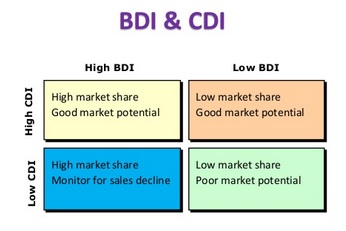- Business Concepts ›
- Marketing and Strategy ›
- Brand Development Index (BDI)
Brand Development Index (BDI)
Definition, Importance & Example
This article covers meaning & overview of Brand Development Index (BDI) from marketing perspective.
What is meant by Brand Development Index (BDI)?
BDI or Brand Development Index is a tool used to measure the relationship between the net sales of a particular brand in a particular market with respect to its population. The Brand Development Index is an index that relates the percent of a brand’s sales in a market to the percent of total market.
Importance of Brand Development Index
BDI or brand development index is used to quantify the relative performance of a particular brand in a defined customer group. It is usually done based on demographics or psychographics. Brand development index helps a company identify strong and weak segments for particular brands. BDI can be used to gauge the presence of brand in a particular market. It goes well with the aggressive and defensive marketing strategies of a brand. For example: A brand employing aggressive marketing strategy will invest more in advertisements in areas having low BDI for its products. Similarly a brand employing defensive marketing strategy will try to further strengthen its hold in areas having high BDI by investing more in those areas. All these strategies help in improving the market share of a brand.
Formula for BDI
BDI can be a useful tool in devising effective market segmentation, targeting strategy and positioning of a brand as it gives a measure of the brand with respect to its market and population of consumers.
BDI = (% of a Brand' s total sales in a particular market )/(% of total population in a particular market ) x 100
The brand development index should be a whole number.
A brand should internally assess it values, uniqueness and what the customer wants. A research needs to take place after a thorough internal assessment. Brand statements distinguish a brand from its competitors and it is very important for all the stakeholders to believe in the brand and demonstrate that belief by satisfying the customer at all touch points.

The companies have to measure both CDI and BDI to come to a conclusion about a market.
There are 4 possibilities
1. High BDI and High CDI- In this case the category as well as brand both are said to be doing well. For example, if we consider Soaps category under that Lux or Dove both will have a high BDI. This indicates that the company should build more on the brand and should be in extension mode.
2. High CDI Low BDI - In this case the category is doing well but the brand is not able to capture the desired market share. For example, in soaps category in a particular market if Margo is not doing well then it will have low BDI. Company should try to attract more customers and try to gain market share.
3. Low CDI High BDI- When a category is not performing well but even then some brands are doing well. For example, the talcum powders segment is degrading still ponds is doing well with around 50-60% market share. Company should try to revive the brand or gradually divest the business.
4. Low CDI High CDI- When a brand as well as category both are not performing then in that case the brand should quickly move out of the business. For example, Spinz or Yardley has very less share of market in a non-performing category.
Example of Brand Development Index
Let us consider the BDI of Dell laptops for a city XYZ of the country PQR.
|
Population of country PQR |
10000 |
|
Population of city XYZ |
2000 |
|
Sales of Dell laptops in country PQR |
500 units |
|
Sales of Dell laptops in area XYZ |
50 units |
BDI of Dell laptops in XYZ = (50/500)*100/ (2000/10000) = 50
Thus, BDI of Dell laptops for a city XYZ is 50.
This value of Brand development index can now further be compared with BDI values of different geographies across countries and the BDI of competitors. It signifies the weak and strong areas for a brand usually on the basis of geographies and population.
Hence, this concludes the definition of Brand Development Index (BDI) along with its overview.
This article has been researched & authored by the Business Concepts Team which comprises of MBA students, management professionals, and industry experts. It has been reviewed & published by the MBA Skool Team. The content on MBA Skool has been created for educational & academic purpose only.
Browse the definition and meaning of more similar terms. The Management Dictionary covers over 1800 business concepts from 5 categories.
Continue Reading:
What is MBA Skool?About Us
MBA Skool is a Knowledge Resource for Management Students, Aspirants & Professionals.
Business Courses
Quizzes & Skills
Quizzes test your expertise in business and Skill tests evaluate your management traits
Related Content
All Business Sections
Write for Us